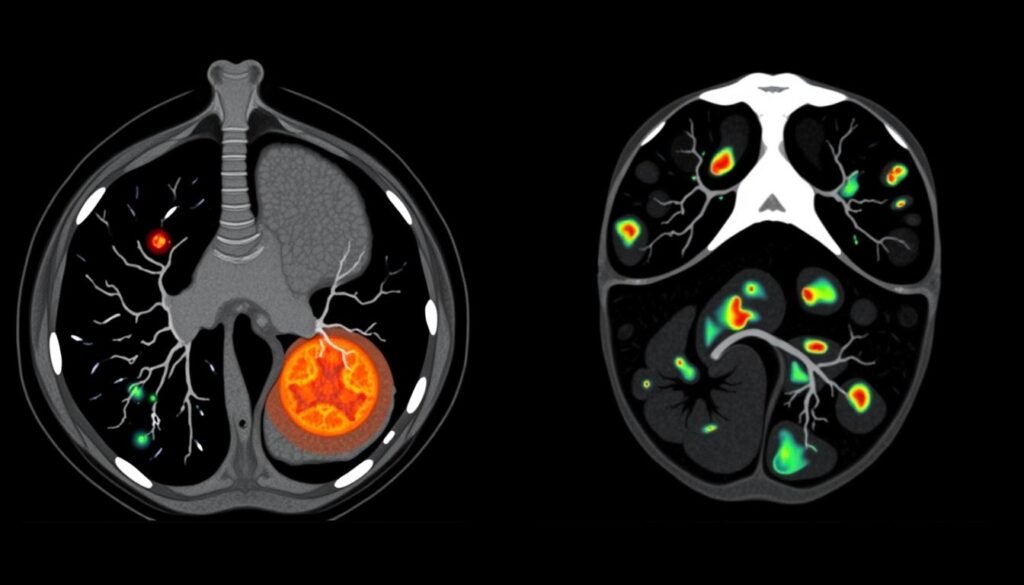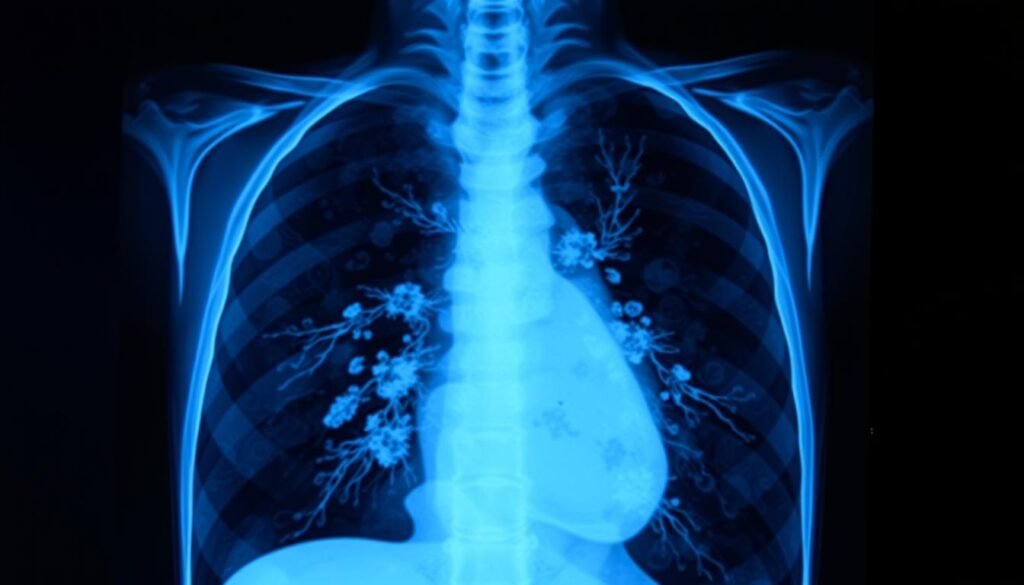About 85% of lung tumors show up as white-grey masses on chest X-rays. For those with stage 4 lung cancer, these X-rays are crucial. They help understand how far the cancer has spread and guide treatment choices. Stage 4 is a severe phase, with cancer moving beyond the lungs. Thus, prompt and correct diagnosis is key. X-rays are very important for spotting tumors or other signs of cancer.
X-rays give a basic look, but with advanced lung cancer, more thorough scans like CTs are often needed. Knowing what stage 4 lung cancer looks like on these tests is crucial. It helps doctors and patients handle the tough journey of this illness. For a closer look at lung cancer on X-rays, check out these detailed images. They show how different kinds of lung cancer appear.
Key Takeaways
- Approximately 85% of lung tumors appear as white-grey masses on chest X-rays.
- X-rays are crucial for initial lung cancer diagnosis but may require further testing for definitive results.
- Stage 4 lung cancer indicates that cancer has spread beyond the lungs.
- CT scans provide a more detailed analysis compared to standard chest X-rays.
- Vigilant screening is recommended for individuals at high risk of developing lung cancer.
Understanding Lung Cancer Staging
Lung cancer staging is crucial for figuring out how serious the disease is. The types of lung cancer, Non-Small Cell Lung Cancer (NSCLC) and Small Cell Lung Cancer (SCLC), have their own staging systems. NSCLC stages go from 0 to IV. Stage 0 is early cancer, and Stage I has two parts based on the tumor.
Stage II is broken down based on tumor size and if lymph nodes are involved. Stage III NSCLC has three sub-stages, IIIA, IIIB, and IIIC. This shows whether cancer has reached the lymph nodes near the lungs. Stage IV means the cancer has spread to other body parts.
Small Cell Lung Cancer is split into limited and extensive stages. In the limited stage, cancer is only in one lung. The extensive stage means it has reached further, even to other organs. How we stage the cancer affects the treatment plan. This helps doctors pick the best treatment for each person’s cancer and overall health.
What is Stage 4 Lung Cancer?
Stage 4 lung cancer is the most advanced phase of this disease. At this stage, the cancer has spread widely, leading to advanced lung cancer. This stage is divided into two categories: 4A and 4B.
Stage 4A involves the spread to nearby lymph nodes or another lung. It may also spread to distant organs like the liver, bones, or brain. Stage 4B shows more extensive spread, reaching multiple areas outside the chest. This includes distant lymph nodes or various organs throughout the body.
The TNM staging system helps identify stage 4. It looks at tumor size, lymph node involvement, and metastasis. This system helps doctors decide on treatment based on how far the cancer has spread.
Talking about lung cancer prognosis is key. Patients with metastatic non-small cell lung cancer have a 5-year survival rate of 8 percent. But, those with cancer that has spread regionally may have a survival rate of 37 percent. For metastatic small cell lung cancer, the rate falls to 3 percent for widespread cases, versus 18 percent for regional spread.
The treatments for stage 4 lung cancer vary based on its type and specifics. Non-small cell lung cancer can be treated with targeted therapies, immunotherapy, or chemotherapy. Small cell lung cancer often uses chemotherapy with or without immunotherapy. Supportive treatments to improve life quality are also important for those with advanced cancer.
Stage 4 Lung Cancer Xray: What Images Show
X-rays are crucial for diagnosing lung cancer early. They help doctors see if there are any unusual spots in the lungs. When doctors examine a stage 4 lung cancer x-ray, they look for signs of lung tumors. Spotting these tumors early on can help decide the best treatment and outlook.
Identifying Lung Tumors on X-rays
In x-ray images, lung cancer might look like visible lumps or nodules. These usually show up as white spots against the dark backdrop of healthy lung areas. Key tumor types seen include:
- Adenocarcinoma
- Large-cell carcinoma
- Squamous-cell carcinoma
Experts check the shape, size, and place of these lumps to figure out the lung cancer type. Knowing how to spot lung tumors is key in stage 4 lung cancer. It affects treatment choices and how doctors look after patients.
Interpreting White Spots on Radiographs
Clinicians focus on white spots on x-rays that might indicate lung cancer. The importance of these spots can change based on their features. Bigger spots might mean the cancer is advanced or has spread. Smaller ones might need closer looks with better imaging methods. Spotting these details helps diagnose lung cancer more accurately.
By thoroughly examining stage 4 lung cancer x-rays, medical teams get a clearer picture of the disease. This insight is vital for suggesting the right treatments, with the goal of improving the chances of recovery.
The Importance of Imaging in Lung Cancer Diagnosis
Imaging is key in finding lung cancer early. Doctors use images to spot tumors and other issues in the lungs. Chest X-rays, CT scans, and PET scans are all important tools. They each offer different information that is crucial for treating patients.
The chest X-ray is often the first step. It’s good for finding big tumors. But, it’s not as effective for small ones, particularly those under 1.5 cm. The detail in X-ray pictures is not always clear enough. Because of this, important signs may be missed. Sadly, 20% to 23% of chest X-rays might not show the cancer, causing delays in treatment.
CT scans are better than chest X-rays for spotting small tumors. They give a clearer picture of the tumor’s size and shape. Doctors recommend yearly CT scans for those at high risk. This can lower the chance of dying from lung cancer early.
For late-stage lung cancer, like stage 4, imaging is even more vital. It shows how far the cancer has spread. This information is key for making treatment plans. Good imaging can help patients live longer, even in advanced cancer stages.
Chest X-rays: A First Step in Diagnosis
Chest X-rays are vital in early lung cancer diagnosis. They start the screening process. These X-rays use radiation to make black-and-white pictures. These pictures show tissue differences, highlighting possible lung issues. They help doctors check lung health and lead to more tests.
How Chest X-rays Work
When doing a chest X-ray, radiation goes through the body. It makes images by showing how tissues absorb radiation. Bones look white, and the lungs look dark. These images can show problems that need more checking. If lung cancer signs are there, doctors may use CT scans for a closer look. Chest X-rays are important for finding lung cancer early.
Advantages and Limitations of Chest X-rays
Chest X-rays are helpful for finding lung cancer. They are fast, easy to find, and not too costly. Yet, they’re not perfect. They might miss small tumors or slight changes in the lungs. This could delay a correct diagnosis. Chest X-rays are a first step but sometimes miss early cancer. So, more tests may be needed to be sure.
| Attribute | Chest X-rays | CT Scans |
|---|---|---|
| Purpose | Initial screening for lung cancer | Detailed imaging to confirm findings |
| Image Quality | Basic overview of lung structures | High-resolution, detailed images |
| Detection of Small Tumors | Limited | More effective |
| Cost | Lower | Higher |
| Radiation Exposure | Lower than CT | Higher than chest X-ray |
It’s key to know the advantages and limitations of these tests for lung cancer. They help get better results for patients through quick and correct care.
Other Imaging Tests for Lung Cancer
There are more tests than just the basic ones for finding lung cancer. CT scans and PET scans are crucial as they offer more details than standard X-rays. They are key for doctors and patients to understand the cancer better.
CT Scans vs. X-rays
CT scans are far better than X-rays in spotting lung issues. X-rays are usually the first step but can miss small tumors. CT scans, however, take pictures from different angles. This helps see the lungs in detail and catch tumors that X-rays might miss.
Let’s look at how they differ:
| Feature | Chest X-ray | CT Scan |
|---|---|---|
| Detail Level | Basic overview | High-resolution cross-sectional images |
| Tumor Detection | Less effective for small tumors | More effective in identifying early-stage tumors |
| Radiation Exposure | Higher than low-dose CT | Lower dose options available (LDCT) |
| Purpose | Initial screening | Staging and treatment planning |
When to Use a PET Scan
PET scans are great for figuring out lung cancer’s stage and diagnosis. They use a special radioactive tracer to find where and how active the cancer is. PET scans help decide the best way to treat it.
This method is key for checking if cancer has spread to lymph nodes or bones. It makes sure patients get the right treatment.

Lung Cancer Symptoms to Look For
Knowing the signs of lung cancer is key for catching it early. People with advanced lung cancer show different symptoms that call for a doctor’s visit. These signs include:
- A cough that gets worse over time, which might mean a tumor is growing in the airways.
- Chest pain or discomfort, suggesting the cancer might be spreading.
- Feeling short of breath, caused by fluid buildup or blockages.
- Being very tired and losing weight without trying, both common with cancer.
- Spitting up blood, a sign of serious health issues.
- Having headaches or seizures, if the cancer has spread to the brain.
Stage 4 lung cancer brings its own set of struggles. Patients often deal with intense pain and look for palliative treatments to feel better. There are ways to handle symptoms of lung cancer symptoms like breathlessness with oxygen therapy and drugs.
Many people with stage 4 lung cancer notice symptoms slowly, which can look a lot like regular sickness at first. This makes it hard to catch it early. Families should watch for end-of-life indicators such as body cooling, confusion, and less hunger.
| Symptom | Related Condition | Treatment Options |
|---|---|---|
| Persistent Cough | Airway Obstruction | Radiation or surgical procedures |
| Shortness of Breath | Fluid Buildup | Oxygen therapy, drainage of pleural effusion |
| Fatigue and Weight Loss | Cancer Cachexia | Palliative care, nutritional support |
| Coughing Up Blood | Advanced Lung Tumors | Emergency intervention, pain management |
| Neurological Problems | Brain Metastasis | Symptom management, potential radiation |
Getting to know these key lung cancer symptoms is vital for quick medical advice. Acting early can lead to better health outcomes and enhance life quality. To learn more about treatment choices and symptom control, check out information on customized treatment plans and palliative care for lung cancer.
Lung Cancer Treatment Options for Stage 4
Stage 4 lung cancer treatments aim to ease symptoms and boost life quality. This stage means the cancer spread beyond the lung. Treatments like chemotherapy, radiation, and targeted therapies are mixed to fit the patient’s cancer traits. Knowing these options helps manage the disease well.
Understanding Chemotherapy and Radiation
Chemotherapy is key in treating lung cancer, mainly non-small cell lung cancer (NSCLC). It aims to reduce tumors and ease symptoms. Treatment usually has four to six cycles of two different chemotherapy drugs. Radiation therapy also plays a part, focusing on cancer areas to lessen pain and discomfort. Together, they help control symptoms from cancer spreading, as in stage 4 NSCLC.
Targeted Therapy for Specific Cancer Types
Targeted therapy is important in modern lung cancer care. It’s used when genetic markers like EGFR mutations or ALK abnormalities are present. These therapies attack cancer cells while leaving healthy cells alone. If no mutations are found, immunotherapy might be used. It boosts the immune system’s ability to fight cancer. For detailed information on lung cancer therapies, visiting lung cancer treatment strategies can help.

Lung Cancer Prognosis: What to Expect
A diagnosis of stage 4 lung cancer is serious. Only about 5 out of 100 people live five years or more. The outcome depends on the patient’s health, the lung cancer type, and therapy response.
Patients with stage 4 lung cancer face hard realities. Early stages have better survival rates. But stage 4 is very challenging. Targeted therapy and immunotherapy bring hope. However, they might not work for everyone. Every patient needs care tailored to their situation.
Knowing what to expect helps patients make better decisions about treatment. This guide provides clear information on the subject. It also helps with the emotional challenges of a diagnosis. Support from doctors and loved ones is crucial.
Monitoring Treatment Effectiveness with X-rays
Regular chest X-rays are key in monitoring lung cancer treatment. They let doctors see how well treatments work and catch any recurrence early. This early detection is vital for the best care.
Doctors use chest X-rays to decide on treatment changes. Guidelines recommend doing this imaging every 6 to 12 months after treatment. This helps spot changes in the tumor or new growths, important due to lung cancer’s tendency to come back.
Let’s look at how X-rays and other scans help manage lung cancer:
| Imaging Type | Frequency | Purpose |
|---|---|---|
| Chest X-ray | Every 6-12 months | Initial monitoring and assessing progression |
| CT scan | Every 6 months for 2 years | Detailed tumor assessment and early detection of recurrence |
| Low-dose CT | Annual for disease-free patients | Long-term surveillance for new cancers |
Chest X-rays are good for regular check-ups, but using different scans ensures thorough monitoring. Research suggests the need for clear rules on which scans to use after treatment, based on each patient’s case.

Conclusion
Understanding how stage 4 lung cancer x-rays help in diagnoses is key for patients and doctors. This method is critical in seeing how far the tumor has spread. It helps decide the best way to treat lung cancer.
Survival rates for lung cancer highlight the importance of catching it early and managing it right. The 5-year survival rate is just 15% across all stages. Doctors often use X-rays and CT scans to check on the cancer’s progress and adjust treatments.
New treatments and care options offer hope to those with stage 4 lung cancer. Supportive care helps patients deal with this tough time. It helps them feel part of a community and builds resilience.